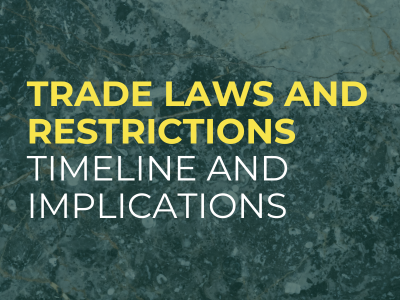
Trade laws and timelines | Update April 2025
In our March blog we published an overview of the context and timeline so far in the ongoing escalation of trade wars between the US and China. In this latest update we provide a commentary and summary of continuing developments and the impact on supply chains.
New export bans and restrictions continue to place critical minerals firmly in the crosshairs of heightening trade tensions. The fallout from the US-China situation sits alongside geopolitical turbulence in US-EU relations and the war in Ukraine, all of which have combined to see countries race to secure critical mineral supplies as uncertainty grows further.
Significant tariffs have now been imposed on imports to the US broadly but specifically on aluminium and steel, intended to strengthen US industry under Section 232 of the Trade Expansion Act of 1962. These tariffs primarily target semi-finished products. Ores are exempt – indicating that the US Administration intends to enable processing and further downstream activities in these industries.
On 4 April 2025 China imposed export restrictions on seven additional minerals – a set of rare earth elements used in the defence, energy and automotive sectors in the US: samarium, scandium, terbium, gadolinium, dysprosium, lutetium, and yttrium. The new restrictions are not an outright ban but require exporting firms to apply for a license for shipments and coincide with the blacklisting by Chinese authorities of many US-based purchasers with links to the defence industry. As the licensing system is not yet up and running, there will likely be a pause in exports to the US while such licensing systems are established, and overall we anticipate ongoing disruptions to supply chains heavily concentrated in China.
On 1 April 2025 the US Secretary of Commerce initiated an investigation into whether restrictions on imports of semiconductors and semiconductor manufacturing equipment poses a threat to US national security. Then more recently, on 15 April 2025 President Trump launched an executive order requesting the Department of Commerce to investigate whether the US’s reliance on critical minerals including cobalt, nickel, and rare earth minerals from China, poses a threat to national security.
Both the US and EU are taking steps to strengthen investment into securing domestic supplies of critical raw materials, including rare earths, that are essential to the aeropsace and defence industries. In March the European Commission unveiled the EU’s first ever defence industrial strategy to improve European defence industrial readiness for the long-term through collaborative EU-based investment, research, development, production, procurement and ownership. In the US, the Department of Defence (DoD) has been working to diversify its sources of critical minerals, directly investing in close partners. Stockpiling of critical minerals is also a key part of the DoD’s strategy, and in addition the DoD has embarked on a five-year rare earth investment strategy to build domestic capacity. China’s dominance of the rare earth supply chain in particular, has emerged as one of its most significant tools in its trade war with the United States. China accounts for 61% of global mined rare earth production, but it controls 92% of global output from the processing stage, rising to 100% for some specific materials. In response, the DoD has set a goal to develop a domestic mine-to-magnet supply chain capable of supporting US defence requirements for rare earth elements by 2027.
It’s clear that sourcing and supply of critical minerals will continue to be used as a pivotal tool within the ongoing trade war situation. TDi will scrutinise developments and the implications for critical mineral supply chains – follow us on social media to stay up to date. And if you’re a downstream company trying to make sense of how the current geopolitical landscape could affect you, get in touch to discuss how our experts can help you identify and mitigate these risks and continue to source responsibly.



